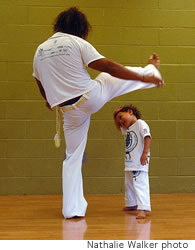Keiki Capoeira
Capoeira Besour combines dance, martial arts moves and acrobatics, all to the beat of a conga drum, and gives kids as young as 2 years old an hour of exercise and fun

By .(JavaScript must be enabled to view this email address)
E-mail this story | Print this page | Archive | RSS

Asher Sprecher dances and kicks with Mestre Kinha
If you didn’t know better walking in front of the Kailua Movement Studio, you’d think the inmates had truly begun running the asylum. Step inside and it may seem like that is exactly what has happened, as a dozen keiki ages 2-6 run, jump, kick, yell and tumble their way around the studio for an hour while their parents sit smiling amid the chaos looking forward to the nap that is almost sure to follow.
It’s a strange scene, indeed, until you realize that these youngsters are learning about a different culture and developing social skills while getting much-needed exercise without even knowing it. Sneaky, eh?
“It’s like controlled play time,” says Wendy Ferri, who brings her son, Diego, 3, and daughter, Kalia, 5, each Wednesday. “It’s perfect. The kids get to play, then they take a break. It’s perfect for their attention span.”

Kaulana Kau practices backflips
with Mestre Kinha
Capoeira Besour is a combination of martial arts, dance, acrobatics and athletics that allows kids to be kids and adults to feel like kids. The class begins with basic stretching exercises, all counted off to the excited yells of the students. From there they execute the basic side-to-side steps that make up the heart of the dance before moving on to other, more complicated movements, all to the rhythmic beats of capoeira music that makes it difficult to simply sit by without somehow getting involved. After breaks, juice boxes and the animated interaction between child, parent and classmates, it’s on to the improvised “play” between teacher and student that unveils the artistry of capoeira and the surprising level of skill among students so small.
“I think it’s a lot of fun,” says Heather Doyle, whose 4-year-old son, Dylan Merkel, has been taking classes for a year-and-a-half. “He’s more into the martial arts portion, but he also really likes the music and the gymnastics.”
At the center of this mass of stumbling, tumbling little bodies is the Brazilian-born capoeira master, Mestre Kinha. To the students, he’s much more than a teacher. He’s a friend, a play toy and the coolest thing there is.

Kaiao Cobeen tumbles under the watchful eye of
Mestre Kinha
“For a long time Diego thought he was a super hero,” says Ferri. “They all love him.”
Though Kinha, born Paulo Linhares da Silva, won’t name his favorite group of students - they range from age 3 to 50-something - his relationship with his youngest students is the most revealing. During the wrap-up portion of the lesson, Kinha plays a conga and chants in Portuguese while the youngsters clamor around him, hugging his legs and climbing on his back. It’s a relationship that the parents appreciate and one that brings a big smile to the master’s face.
“When I teach kids, I become a kid too,” Kinha says simply.
While it is surely lost on the young students, the history and legends of capoeira add interest to this unique and slightly mysterious activity. Born among the West African slaves who were brought to Brazil to work on sugar plantations in the 18th century, music and dance elements were added to their traditional fighting style to hide it from slave owners, who feared the skill would be used against them. There was so much concern about capoeira that it was outlawed for more than 30 years around the turn of the 20th century, as it was associated with lawless gangs.

Koah Kraft contemplates her next
move
Now considered a national sport second only to soccer, capoeira’s influence can be seen internationally among break dancers, who have taken exact movements from the dance, and even Hollywood. If you’re curious how master thief François Toulour of Ocean’s 12 got around the laser security system that protected the rare Faberge egg, it was capoeira that allowed him to move smoothly through the ever-changing obstacle.
Although Kinha says the martial arts and dance portions go hand-in-hand, the self-defense portions have no part in his teachings - especially with the younger kids, who he monitors with their parents to ensure that the children are learning the right lessons.
“I try to find the personality of each student in the class, and then ask the parents how the kids behave after taking the class. If they go home and spend their time practicing, they don’t have time to make trouble,” he says.
Another of those most important lessons is maintaining a healthy lifestyle. With childhood obesity a major problem in Hawaii and elsewhere as the population becomes more sedentary, Kinha stresses that it is important for children to learn about
Page 1 of 2 pages for this story 1 2 >
E-mail this story | Print this page | Comments (0) | Archive | RSS
Most Recent Comment(s):








